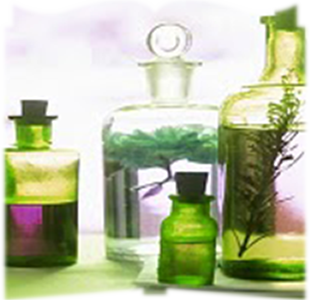 Tinctures can be used to prepare roots or leaves. They include alcohol and water to extract the properties from the herbs which would not be available id a water preparation alone was used. It is possible to replace the alcohol with glycerol or vinegar.
Tinctures can be used to prepare roots or leaves. They include alcohol and water to extract the properties from the herbs which would not be available id a water preparation alone was used. It is possible to replace the alcohol with glycerol or vinegar.
A tincture will last for up to two years, which makes it a very convenient method if you intend long-term use of the herbs. A tincture is much stronger than either an infusion or a decoction, and is taken in milliliters (ml) or teaspoons (tsp) depending on the herb used. Use a dropper to measure amounts. In general, 20 drops is equivalent to 1 ml.
Method
200 g (8 oz) dried herb
250 ml (½ pint) alcohol*
750 ml (1 ½ pints) water
*the alcohol should be at least 30 percent proof in order to extract constituents and to preserve them. Suitable mediums include gin and vodka. Never use industrial alcohol.
The ratio of herb to liquid is one part herb to one part liquid. The liquid is made up of 25 percent alcohol and 75 percent water.
Finely chop the herbs and place them in a glass vessel or jar with a tightly fitting lid. Cover the herbs with the liquid and secure the lid. The jar should be placed in a warm, dark place for 14 days. Shake the mixture every two or three days. At the end of this time, strain the mixture into a clean jar, keeping the remains of the wet herbs to one side. These can e pressed to extract every drop of the tincture by using a wine press if you have one, or by wrapping the herbs in a muslin cloth and wringing out the last few drops. Keep the tincture in a colored glass jar or bottle, and store in a dark place.
Tincture for Sleeplessness
100 g (4 oz) German chamomile
250 ml (½ pint) vodka
750 ml (1 ½ pints) water
This tincture is excellent as an aid to restful sleep. Begin by taking 5 ml (1 tsp) approximately 20 minutes before going to bed. If this is not effective take a further 5 ml (1 tsp). You may take a maximum of 3 tsp (15 ml) in one night. The next evening you could begin with 10 ml (2 tsp) and so on until you find the most effective dose for your needs.
Always label tinctures with the name of the herb and the date prepared. A notebook is useful to record ailments treated and successful herbal combinations.
If you appreciate the information provided,
please help keep this website running. Blessings!
© 2008-2025 aromaworx.ca. All rights reserved.

